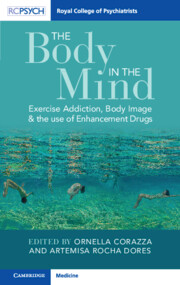Book contents
- The Body in the Mind
- The Body in the Mind
- Copyright page
- Dedication
- Contents
- Figures
- Tables
- Boxes
- Contributors
- Acknowledgements
- Introduction
- Section 1 From Exercise to Addiction: An Introduction to the Phenomenon
- Section 2 Reaching the Extreme with Exercise: A Collection of Clinical Case Studies
- Chapter 11 Being Versus Appearing: Two Sides of the Same Coin?
- Chapter 12 Reducing Excessive Exercise Behaviour Using Online Cognitive–Behavioural Therapy
- Chapter 13 The Story of My Life
- Chapter 14 Money Honey
- Section 3 Exploring the Motivations Behind Exercise Addiction
- Index
- References
Chapter 12 - Reducing Excessive Exercise Behaviour Using Online Cognitive–Behavioural Therapy
The Case of a Middle-Aged Adult
from Section 2 - Reaching the Extreme with Exercise: A Collection of Clinical Case Studies
Published online by Cambridge University Press: 30 March 2023
- The Body in the Mind
- The Body in the Mind
- Copyright page
- Dedication
- Contents
- Figures
- Tables
- Boxes
- Contributors
- Acknowledgements
- Introduction
- Section 1 From Exercise to Addiction: An Introduction to the Phenomenon
- Section 2 Reaching the Extreme with Exercise: A Collection of Clinical Case Studies
- Chapter 11 Being Versus Appearing: Two Sides of the Same Coin?
- Chapter 12 Reducing Excessive Exercise Behaviour Using Online Cognitive–Behavioural Therapy
- Chapter 13 The Story of My Life
- Chapter 14 Money Honey
- Section 3 Exploring the Motivations Behind Exercise Addiction
- Index
- References
Summary
One of the most challenging aspects of exercise addiction (EA) is that it is a behaviour that is positively reinforced in the community. Moreover, accompanying non-adaptive eating behaviours make this problem more complicated. Evidence has shown that people with EA are mostly ambivalent and can be resistant to change. Therefore an understanding of individual differences and comorbidity factors may be important when choosing the most appropriate disorder-specific treatment. This chapter presents the case of a 38-year-old woman who exhibited excessive exercise and binge-eating behaviours. In addition to 12 sessions of online cognitive–behavioural therapy, some mindfulness-based techniques were used to elicit emotional awareness in this patient throughout her treatment. At the end of the intervention, her mood was improved, and she began to use more effective ways of coping with negative emotions. This case may also shed light on the importance of limitations and barriers to treatment adherence.
Keywords
Information
- Type
- Chapter
- Information
- The Body in the MindExercise Addiction, Body Image and the Use of Enhancement Drugs, pp. 171 - 176Publisher: Cambridge University PressPrint publication year: 2023
